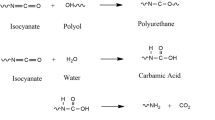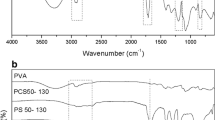Abstract
Two nonionic FAEO (fatty alcohol ethoxylated) surfactants with varying solubility were obtained by the reaction of lauryl-myrisityl alcohol (LMA) with ethylene oxide to yield lauryl-myristyl/alcohol ethoxylated with 3 and 31 mol of ethylene oxide by changing the length of polyethylene glycol segment. The prepared surfactants, designated as LMAEO-3 and LMAEO-31, were characterized for their structures using spectroscopic measurements; in addition, their surface properties were investigated. The results indicated that LMAEO-31 exhibits excellent surface activity. Evaluation of the surfactants as wetting agents, anti-foamers, and minimum film forming temperature (MFFT) reducer in emulsion polymer lattices achieved promising results indicating high performance in the mentioned industrial applications.




Similar content being viewed by others
References
Edwards CL. Nonionic surfactants. Surfactant Sci Ser. 1998;72:87–121.
Schick MJ. Nonionic surfactants. New York: Marcel Dekker; 1966.
Schick MJ. Nonionic surfactants: physical chemistry. New York: Marcel Dekker; 1987. p. 438.
Schonfeldt N. Surface active ethylene oxide adducts. Oxford: Pergamon Press; 1970.
Van Os NM. Nonionic surfactants: organic chemistry. Surfactant science series, vol. 72. New York: Marcel Dekker Inc; 1998. p. vii–x.
Porter MR. Handbook of surfactants. 2nd ed. New York: Blackie; 1994.
Kirshenbaum I, Inchalik EJ. In: Grayson M, Eckroth D, editors. Kirk-Othmer encyclopedia of chemical technology. 3rd ed. vol. 16, New York: John Wiley & Sons;1981. p. 637–53.
Gautreaux MF, Davis WT, Travis ED (1978) In: Grayson M, Eckroth D (eds) Kirk-othmer encyclopedia of chemical technology. 3rd ed., vol. 1, New York: John Wiley & Sons; p. 740–754.
Santacesaria E, Di Serio M, Garaffa R. Kinetics and mechanisms of fatty alcohol polyethoxylation. 1. The reaction catalyzed by potassium hydroxide. Ind Eng Chem Res. 1992;31:2413–8.
Li JL, Chen BH. Recovering phenanthrene from spiked sand by a combined remediation process of micellar solubilization and cloud-point extraction. J Chin Inst Chem Eng, 2008;39:337–42.
Kenkare PU, Hall CK, Kilpatrick PK. The effects of salts on the lower consolute boundary of a nonionic micellar solution. J. Colloid Interf Sci. 1996;184:456–68.
Schott H. Effect of inorganic additives on solutions of nonionic surfactants—XVI. Limiting cloud points of highly polyoxyethylated surfactants. Colloid Surf A. 2001;186:129–36.
Huang Z, Gu T. The effect of mixed cationic-anionic surfactants on the cloud point of nonionic surfactant. J Colloid Interf Sci. 1990;138:580–2.
Kumar S, Sharma D, Khan ZA, Kabir-ud-Din. Salt-induced cloud point in anionic surfactant solutions: role of the headgroup and additives. Langmuir. 2002;18:4205–9.
Van Os NM, Haak JR, Rupert LAM. Physico-chemical properties of selected anionic, cationic and nonionic surfactants. Amsterdam: Elsevier; 1993.
Hsiao L, Dunning HN, Lorenz PB. Critical micelle concentrations of polyoxyethylated non-ionic detergents. J Phys Chem. 1956;60:657–60.
Balson T, Felix MSB. The biodegradability of non-ionic surfactants. In: Karsa DR, Porter MR, editors. Biodegradability of surfactants. London: Blackie Academic and Professional; 1995. p. 204–30.
Alejski K, Bialowas E, Hreczuch W, Trathnigg P, Szymanowski J. Oxyethylation of fatty acid methyl esters. Molar ratio and temperature effects. Pressure drop modeling. Ind Eng Chem Res. 2003;42:2924–33.
Negm NA, Elkholy YM, Ghuiba FM, Zahran MK, Mahmoud SA, Tawfik SM. Benzothiazol-3-ium cationic schiff base surfactants: synthesis, surface activity and antimicrobial applications against pathogenic and sulfur reducing bacteria in oil fields. J Dispers Sci Technol. 2011;32:512–8.
ASTM D2024-09 (2009) Standard test method for cloud point of nonionic surfactants. ASTM International, West Conshohocken. www.astm.org.
ASTM D1173-07 (2007) Standard test method for foaming properties of surface-active agents. ASTM International, West Conshohocken. www.astm.org.
Denkov ND. Mechanisms of foam destruction by oil-based antifoams. Langmuir. 2004;20:9463–505.
Saito Y, Sato T, Anazawa I. Correlation between distribution of oxyethylene chain and physicochemical properties of nonionic surfactants. Yakuzaigaku. 1989;49:180–3.
Zheng J, Luo J, Zhou D, Shen T, Li H, Liang L, Lu M. Preparation and properties of non-ionic polyurethane surfactants. Colloids and Surfaces A: physicochem. Eng Aspects. 2010;363:16–21.
ASTM D2281-10 (2010) Standard test method for evaluation of wetting agents by the skein test. ASTM International, West Conshohocken. www.astm.org.
Draves CZ, Clarkson RG. A new method for the evaluation of wetting agents. Am Dyest Rep. 1931;20:201–9.
Ananthapadmanabhan KP, Goddard ED, Chandar P. A study of the solution, interfacial and wetting properties of silicone surfactants. Colloids Surf. 1990;44:281–97.
Rosen MJ, Song LD. Superspreading, skein wetting, and dynamic surface tension. Langmuir. 1996;12:4945–9.
Arnaudov L, Denkov ND, Surcheva I, Durbut P, Broze G, Mehreteab A. Effect of oily additives on the foam ability and foam stability. 1. Role of interfacial properties. Langmuir. 2001;17:6999–7010.
Basheva ES, Ganchev D, Denkov ND, Kasuga K, Satoh N, Tsujii K. Role of betaine as foam booster in the presence of silicone oil drops. Langmuir. 2000;16:1000–13.
Wasan DT, Christiano SP (1997) Foams and antifoams: a thin film approach. In: Birdi KS (ed.) Handbook of surface and colloid chemistry. CRC Press, New York, Chapter 6.
Denkov ND, Marinova K, Hristova H, Hadjiiski A, Cooper P. Mechanisms of action of mixed solid-liquid antifoams. 3. Exhaustion and reactivation. Langmuir. 2000;16:2515–28.
ASTM D2354-10e1 (2010) Standard test method for minimum film formation temperature (MFFT) of Emulsion Vehicles. ASTM International, West Conshohocken, PA. www.astm.org.
Hall CA, Agrawal PK. Separation of kinetics and mass-transfer in a batch alkoxylation reaction. Can J Chem Eng. 1990;68:104–12.
Reichenbächer M, Popp J. Challenges in molecular structure determination. Chapter 2 Vibrational Spectroscopy. Berlin Heidelberg: Springer-Verlag; 2012.
Negm NA, Mohamed AS. Surface and thermodynamic properties of diquaternary bola-form amphiphiles containing an aromatic spacer. J Surf Deterg. 2004;7:23–30.
Griffin WC. Classification of surface-active agents by “HLB”. J Soc Cosmet Chem. 1949;1:311–26.
Griffin WC. Emulsification. Sagarin E. New York: Cosmetics: Science and Technology Interscience Publishers; 1957. p. 998–1033.
Schott H. Hydrophile-lipophile balance and cloud points of nonionic surfactants. J Pharm Sci. 1969;58:1443–9.
Rosen MJ (1984) Structure/Performance Relationships in Surfactants (ed.) American Chemical Society, Washington.
Al-Sabagh AM, Ahmed NS, Nassar AM, Gabr MM. Synthesis and evaluation of some polymeric surfactants for treating crude oil emulsions Part I: treatment of sandy soil polluted with crude oil by monomeric and polymeric surfactants. Colloids Surf A physicochem Eng Aspects. 2003;216:9–19.
Tadros TF. Applied Surfactants: Principles and Applications. Weinheim: Wiley-VCH Verlag GmbH & Co. KGaA; 2005.
Xu Q, Wang L, Xing F. Synthesis and properties of dissymmetric gemini surfactants. J Surfact Deterg. 2011;14:85–90.
Denkov ND, Marinova K, Tcholakova S, Deruelle M (2002) Mechanism of foam destruction by emulsions of PDMS-silica mixtures. In: Proceedings 3rd World Congress on Emulsions, 24–27, Lyon, France; paper 1-D-199.
Garrett PR (1993) The mode of action of antifoams. In: Garrett PR (ed) defoaming: theory and industrial applications, Marcel Dekker: New York, Chapter 1.
Erbil HY. Vinyl Acetate Copolymerization with Acrylic Monomers. In vinyl acetate emulsion polymerization and copolymerization with acrylic monomers: CRC Press; 2000 Chapter 5.
Winnik MA. The formation and properties of latex films. In: El-Aasser MS, Lovell PA, editors. Emulsion polymerization and emulsion polymers. London: Wiley; 1997.
Author information
Authors and Affiliations
Corresponding author
About this article
Cite this article
Abd El-Ghaffar, M.A., Sherif, M.H. & Taher El-Habab, A. Synthesis, Characterization, and Evaluation of Ethoxylated Lauryl-Myrisityl Alcohol Nonionic Surfactants as Wetting Agents, Anti-Foamers, and Minimum Film Forming Temperature Reducers in Emulsion Polymer Lattices. J Surfact Deterg 20, 117–128 (2017). https://doi.org/10.1007/s11743-016-1898-4
Received:
Accepted:
Published:
Issue Date:
DOI: https://doi.org/10.1007/s11743-016-1898-4




